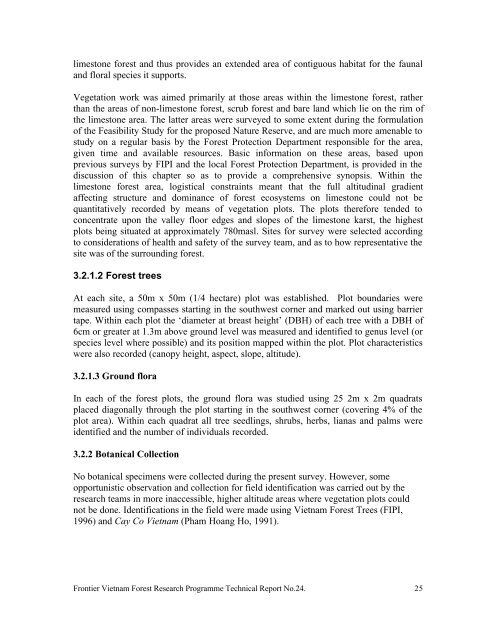Kim Hy Proposed Nature Reserve - Frontier-publications.co.uk
Kim Hy Proposed Nature Reserve - Frontier-publications.co.uk
Kim Hy Proposed Nature Reserve - Frontier-publications.co.uk
You also want an ePaper? Increase the reach of your titles
YUMPU automatically turns print PDFs into web optimized ePapers that Google loves.
limestone forest and thus provides an extended area of <strong>co</strong>ntiguous habitat for the faunal<br />
and floral species it supports.<br />
Vegetation work was aimed primarily at those areas within the limestone forest, rather<br />
than the areas of non-limestone forest, scrub forest and bare land which lie on the rim of<br />
the limestone area. The latter areas were surveyed to some extent during the formulation<br />
of the Feasibility Study for the proposed <strong>Nature</strong> <strong>Reserve</strong>, and are much more amenable to<br />
study on a regular basis by the Forest Protection Department responsible for the area,<br />
given time and available resources. Basic information on these areas, based upon<br />
previous surveys by FIPI and the local Forest Protection Department, is provided in the<br />
discussion of this chapter so as to provide a <strong>co</strong>mprehensive synopsis. Within the<br />
limestone forest area, logistical <strong>co</strong>nstraints meant that the full altitudinal gradient<br />
affecting structure and dominance of forest e<strong>co</strong>systems on limestone <strong>co</strong>uld not be<br />
quantitatively re<strong>co</strong>rded by means of vegetation plots. The plots therefore tended to<br />
<strong>co</strong>ncentrate upon the valley floor edges and slopes of the limestone karst, the highest<br />
plots being situated at approximately 780masl. Sites for survey were selected ac<strong>co</strong>rding<br />
to <strong>co</strong>nsiderations of health and safety of the survey team, and as to how representative the<br />
site was of the surrounding forest.<br />
3.2.1.2 Forest trees<br />
At each site, a 50m x 50m (1/4 hectare) plot was established. Plot boundaries were<br />
measured using <strong>co</strong>mpasses starting in the southwest <strong>co</strong>rner and marked out using barrier<br />
tape. Within each plot the ‘diameter at breast height’ (DBH) of each tree with a DBH of<br />
6cm or greater at 1.3m above ground level was measured and identified to genus level (or<br />
species level where possible) and its position mapped within the plot. Plot characteristics<br />
were also re<strong>co</strong>rded (canopy height, aspect, slope, altitude).<br />
3.2.1.3 Ground flora<br />
In each of the forest plots, the ground flora was studied using 25 2m x 2m quadrats<br />
placed diagonally through the plot starting in the southwest <strong>co</strong>rner (<strong>co</strong>vering 4% of the<br />
plot area). Within each quadrat all tree seedlings, shrubs, herbs, lianas and palms were<br />
identified and the number of individuals re<strong>co</strong>rded.<br />
3.2.2 Botanical Collection<br />
No botanical specimens were <strong>co</strong>llected during the present survey. However, some<br />
opportunistic observation and <strong>co</strong>llection for field identification was carried out by the<br />
research teams in more inaccessible, higher altitude areas where vegetation plots <strong>co</strong>uld<br />
not be done. Identifications in the field were made using Vietnam Forest Trees (FIPI,<br />
1996) and Cay Co Vietnam (Pham Hoang Ho, 1991).<br />
<strong>Frontier</strong> Vietnam Forest Research Programme Technical Report No.24. 25
















